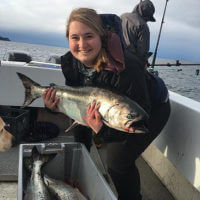Grand Valley State University, B.Sc. Biology, animal concentration
Growing up in Michigan, I spent most summers on the lake either fishing or boating. This ultimately fostered both a love for being outdoors and a curiosity to know more about the organisms around me. To explore this curiosity, I attended Grand Valley State University (GVSU) and obtained a B.S. degree in Biology and a concentration in Animal Biology. In my time spent at GVSU, I took every opportunity I had to work on aquatic research projects including: a shark and stingray population census with Coastal Marine Education and Research Academy in Florida, assisting GVSU graduate student research on macroinvertebrate genetic diversity in neighboring tributary streams, and various research and fish stocking projects with the Michigan Department of Natural Resources. I also spent several years volunteering at John Ball Zoo on the Animal Care Team and I am a certified PADI Open Water Diver.
The working title of my thesis is “Does fishing disturbance explain the spatiotemporal distribution of structure-forming benthic features important for red king crabs in the central and eastern Bering Sea?” Stationary biological, biogenic, or geological seabed elements (Fig. 1) represent an important refuge from disturbance and predation for juvenile red king crab (Paralithodes camtschaticus; Fig. 2). Fishing with bottom-tending fishing gears (e.g. trawls, dredges, pots, longlines) is a potential source of disturbance or removal of these structure-forming features. Risk to exposure from fishing disturbance is related to (1) a features inherent trait (e.g. size, height, body form), and (2) the frequency of feature exposure to fishing events. In 1996, the Red King Crab Savings Area (RKCSA) and Nearshore Bristol Bay Trawl Closure (NBBTC) were implemented with the goal of protecting juvenile and adult red king crab from non-target fishery induced mortality.
To date, no studies have examined the effectiveness of these closures for mitigating the impacts of fishing on presence of structural benthic features important for red king crab. Information on the presence and absence of the structural features since 1982 is drawn from the National Marine Fisheries Service (NMFS) trawl survey database. Exposure to fishing disturbances is assessed as a function of 1) area status (open vs. closed to fishing), 2) habitat disturbance as predicted by the North Pacific Fishing Effects model, and 3) the frequency of and time since last fishing disturbance. This project leverages existing data products and modeling efforts to examine the spatiotemporal distribution of structure-forming benthic features in the RKCSA, NBBTC, and adjacent open areas relative to fishing disturbances.
Collaborators: Chris McGonigle, Bob Foy
Funding for this work is provided by the Groundfish Forum via the Alaska Education Tax Credit Program.

